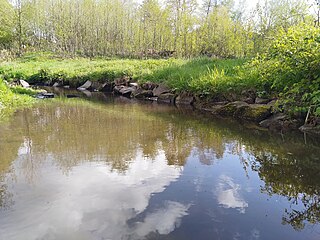
The Oxford English Dictionary (OED) is the principal historical dictionary of the English language, published by Oxford University Press (OUP), a University of Oxford publishing house. The dictionary, which published its first edition in 1884, traces the historical development of the English language, providing a comprehensive resource to scholars and academic researchers, and provides ongoing descriptions of English language usage in its variations around the world.

The Norsemen were a North Germanic linguistic group of the Early Middle Ages, during which they spoke the Old Norse language. The language belongs to the North Germanic branch of the Indo-European languages and is the predecessor of the modern Germanic languages of Scandinavia. During the late eighth century, Scandinavians embarked on a large-scale expansion in all directions, giving rise to the Viking Age. In English-language scholarship since the 19th century, Norse seafaring traders, settlers and warriors have commonly been referred to as Vikings. Historians of Anglo-Saxon England distinguish between Norse Vikings (Norsemen) from Norway, who mainly invaded and occupied the islands north and north-west of Britain, as well as Ireland and western Britain, and Danish Vikings, who principally invaded and occupied eastern Britain.

Lancashire hotpot is a stew originating in Lancashire in the North West of England. It consists of lamb or mutton and onion, topped with sliced potatoes and slowly baked in a pot at a low heat.

Hottentot is a term that was historically used by Europeans to refer to the Khoekhoe, the indigenous nomadic pastoralists in South Africa.

A merkin is a pubic wig. Merkins were worn by prostitutes after shaving their mons pubis, and are used as decorative items or erotic devices by both men and women.
Mackem, Makem or Mak'em is a nickname for residents of and people from Sunderland, a city in North East England. It is also a name for the local dialect and accent ; and for a fan, of whatever origin, of Sunderland A.F.C. It has been used by the people of Sunderland to describe themselves since the 1980s, prior to which it was mainly used in Tyneside as a disparaging exonym. An alternative name for a Mackem is a Wearsider.

A body of water or waterbody is any significant accumulation of water on the surface of Earth or another planet. The term most often refers to oceans, seas, and lakes, but it includes smaller pools of water such as ponds, wetlands, or more rarely, puddles. A body of water does not have to be still or contained; rivers, streams, canals, and other geographical features where water moves from one place to another are also considered bodies of water.
Folk etymology – also known as (generative) popular etymology, analogical reformation, (morphological)reanalysis and etymological reinterpretation – is a change in a word or phrase resulting from the replacement of an unfamiliar form by a more familiar one through popular usage. The form or the meaning of an archaic, foreign, or otherwise unfamiliar word is reinterpreted as resembling more familiar words or morphemes.
Orthoepy is the study of pronunciation of a particular language, within a specific oral tradition. The term is from the Greek ὀρθοέπεια orthoepeia, from ὀρθός orthos and ἔπος epos. The antonym is cacoepy "bad or wrong pronunciation". The pronunciation of the word orthoepy itself varies widely; the OED recognizes the variants, ,, and for British English, as well as for American English.

Allium fistulosum, the Welsh onion, also commonly called bunching onion, long green onion, Japanese bunching onion, and spring onion, is a species of perennial plant, often considered to be a kind of scallion.

A yard is an area of land immediately adjacent to one or more buildings. It may be either enclosed or open. The word may come from the same linguistic root as the word garden and has many of the same meanings.
Malkin as a surname may refer to:
In Modern English, I is the singular, first-person pronoun.
In folkloristics, folk belief or folk-belief is a broad genre of folklore that is often expressed in narratives, customs, rituals, foodways, proverbs, and rhymes. It also includes a wide variety of behaviors, expressions, and beliefs. Examples of concepts included in this genre are magic, popular belief, folk religion, planting signs, hoodoo, conjuration, charms, rootwork, taboos, old wives' tales, omens, portents, the supernatural and folk medicine.

Roden is the old designation of the coastal areas of Svealand, that in wartime would man and equip the ships that sailed out in ledung.

The nameplate or masthead of a newspaper or periodical is its designed title as it appears on the front page or cover. Another very common term for it in the newspaper industry is "the flag". It is part of the publication's branding, with a specific font and, usually, color. It may include other details besides the name, such as ornamentation, a subtitle, or motto. For example, the masthead of The Times of London includes the British Royal Arms between the words "The" and "Times". Another example is the masthead of Daily Record of Scotland, which includes an ornamental lion in the "rampant" attitude to the right of the word "Daily".
The sanctorale is one of the two main cycles that, running concurrently, comprise the Liturgical year in Roman Catholicism, defined by the General Roman Calendar, and used by a variety of Christian denominations.










